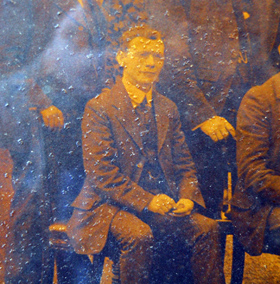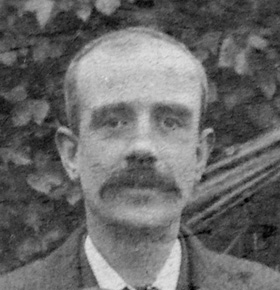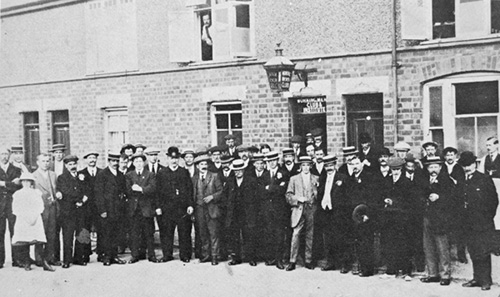Early Days of the Working Men’s Club
(Published in the Kenilworth Weekly News, 1st April 2011. Lack of space the previous week delayed the publication from the club’s centenary day)
Today is the centenary of the official opening of the Working Men’s Club, now on Upper Rosemary Hill.
A working men’s club existed in The Square in the Victorian years but it closed in 1886 soon after the source of most of its members, the tannery, shut down. From 1889 to 1892, a “Conservative Woking Men’s Club” existed at what is today’s Priory Road fish and chip shop.
The subsequent absence of a club for the working men of the town was often commented upon and in the early years of the 20th century, the vicar of St Nicholas, the Reverend Hanning, several times called for one to be formed.
It finally came about due to group of locals having a pint after a bicycle ride in late 1910. They settled down in The Wyandotte and one of them, Harry Yardley (in his early 30’s), suggested to his pal Claude Holmes (in his late 20’s) that it would be a good idea for the group to have a pub or club of their own. This led to a search for premises and local builder Alfred Satchwell suggested two of the houses he was then building in Albion Street, numbers 3 & 5, could be rented and converted into a club. The only stipulation was that should they leave the premises, they would have to convert them back into two houses. In the event, the only alteration appears to have been the provision of an internal door linking the two houses.
The first general meeting took place on 14th February 1911 at the club, and tannery owner and leading councillor Charles Randall was elected to the chair. A committee was appointed from the 50 or so present, and Randall became club President.
The club opened on 4th March 1911. In the bar, beer was either from bottles or straight from a barrel; crates served as seats, standing barrels as tables, and the floor was bare. Entertainment was provided by a solitary bagatelle table, card games and dominoes. By the time of the formal opening on 25th March 1911 by Mrs Randall, there was lino on the floor. The landowner, Alfred Satchwell, kept a close eye on his property as he became the first steward and lived in the combined upper-floors.
Out of a membership of 186, 48 were serving in the Great War in early 1918, and by its end, ‘The Club’, as it became affectionately known, was looking for improved premises. Three cottages with a good size of surrounding ground opposite The Albion Tavern had been bought for about £400 with thoughts to the future, but in late 1918, the very large and nearby Montague House became available and the club decided to buy it at a cost of £2,200. It stood in an acre and a half of grounds and included a bowling green. With the contract entered into, Charles Randall stepped in to ensure there was no financial burden to the club by buying Montague House and leasing it back to them. Randall also gave £100 to help furnish the new premises. The move took place on 22nd March 1919.
Numbers 3 & 5 Albion Street were converted back as agreed and became two shops, and today are two houses. The other site in Albion Street was sold; it is thought that today’s numbers 56 & 58 are the cottages that nearly became the enlarged Working Men’s Club.
The membership grew rapidly after the Great War and by April 1920, it had over 640 members. The children of the members were always well catered for; in 1924 for example over 400 of them were treated to a Christmas party. It is a little known fact that an event arranged for the children of the Working Men’s Club, an annual summer party and parade through town, led the way to establishing Kenilworth’s Carnival. Over 400 children took part in the parade in 1925 and indeed the same number led the first Kenilworth carnival proper the following year, organised by the Club’s Committee.
Day trips for members were also organised and these included a visit to the M & B brewery in 1923 and the Wembley Exhibition of 1924.
The high number of members caused a whole variety of activities to be indulged. The obvious first one at the new premises was a bowling team, utilising the green that already existed at Montague House. A brass band was formed, a fishing club and an annual flower show (started in 1911) were amongst other activities. An ex-naval officer set up a gym and in 1927, a large extension was added to house a billiard and concert room.
The club had established itself as the major place of recreation in Kenilworth and today with about 200 active members, as a Sports and Social Club, it is still a vital part of the town.
 |
 |
Harold Yardley (left) from a photograph taken of the WMC first committee, and Claudius Holmes, usually shortened to Claud, from a photograph of the 1919 committee – the two men responsible for the starting of the club.
Taken from two very faded originals, with thanks to members of the modern Sports & Social Club.

The only known photograph of the club whilst still in Albion Street. It is likely that the gentleman at the upstairs window is landlord and first steward Alfred Satchwell who lived on the upper floors.